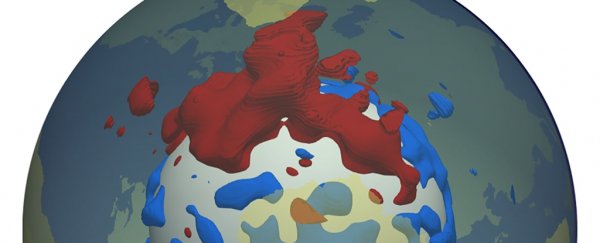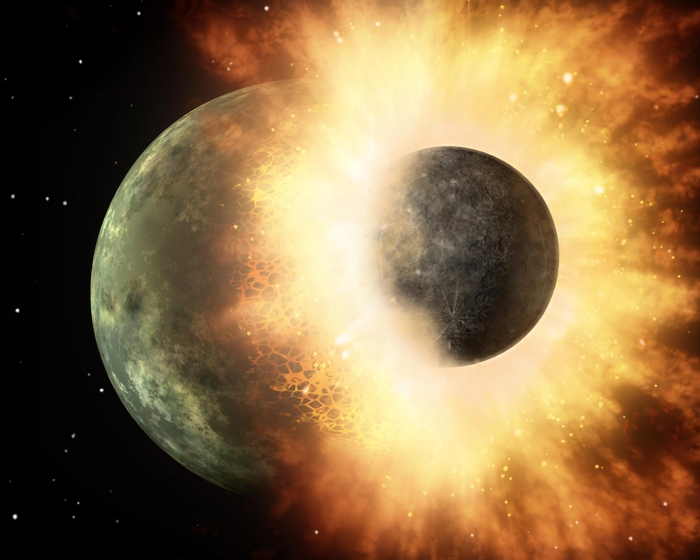
Vast Fragments of an Alien World Could Be Buried Deep Within Earth Itself
PETER DOCKRILL
24 MARCH 2021
They are among the largest and strangest of all structures on Earth: huge, mysterious blobs of dense rock lurking deep within the lowermost parts of our planet's mantle.
There are two of these gigantic masses – called the large low-shear-velocity provinces (LLSVPs) – with one buried under Africa, the other below the Pacific Ocean.
These anomalies are so massive, they in turn breed their own disturbances, such as the large phenomenon currently evolving within and weakening Earth's magnetic field, known as the South Atlantic Anomaly.
As for how and why the LLSVPs came to exist like this within the mantle, scientists have lots of ideas, but little in the way of hard proof.
What is known, however, is that these giant blobs have been around for a very long time, with many thinking they could have been a part of Earth since before the giant impact that birthed the Moon – ancient traces of the collision between Earth and the hypothetical planet Theia.

Artist's impression of a planetary collision. (NASA/JPL-Caltech)
According to that widely held argument, the Mars-sized Theia struck the very early Earth around 4.5 billion years ago, with a huge chunk of Theia and/or possibly Earth fragmenting off, and becoming the Moon we know today in orbit around Earth.
As for what happened to the rest of Theia, it's uncertain. Was it destroyed, or did it simply ricochet off into the eternity of space? We don't know.
Some researchers have suggested the cores of these two primordial planets may have fused into one, and that chemical exchanges wrought by this epic merger are what enabled life itself to thrive on the world that resulted.
Now, scientists have returned to these monumental questions with a new proposal, and it's an idea that reconciles the mysterious LLSVP blobs too, weaving them into the Earth/Theia hybrid hypothesis.
According to new modeling by researchers from Arizona State University (ASU), the LLSVPs may represent ancient fragments of Theia's iron-rich and highly dense mantle, which sank deep into Earth's own mantle when the two developing worlds came together, and has been buried there for billions of years.
"The Giant Impact hypothesis is one of the most examined models for the formation of Moon, but direct evidence indicating the existence of the impactor Theia remains elusive," the researchers, led by first author Qian Yuan, a PhD candidate studying mantle dynamics at ASU, explain in a summary of their findings presented last week at the Lunar and Planetary Science Conference.
"We demonstrate that Theia's mantle may be several percent intrinsically denser than Earth's mantle, which enables the Theia mantle materials to sink to the Earth's lowermost mantle and accumulate into thermochemical piles that may cause the seismically-observed LLSVPs."
While speculation has existed for years that the LLSVPs may be an alien souvenir implanted by Theia, the new research appears to be the most comprehensive formulation yet. The findings are currently under review, ahead of future publication in Geophysical Research Letters.
Beyond the mantle modeling, the results are also consistent with previous research suggesting that certain chemical signatures tied to the LLSVPs are at least as primitive as the Theia impact.
"Therefore, the primitive materials may [originate] from the LLSVPs, which is well explained if the LLSVPs preserve Theia mantle materials that are older than the Giant Impact," Yuan and his co-authors write.
We'll have to see how the rest of the scientific community respond to the team's findings, but for now at least, we've got another lead on just what these mysterious anomalies might be – and it's literally the most far-out explanation yet.
"This crazy idea is at least possible," Yuan told Science.
The findings were presented at the 52nd Lunar and Planetary Science Conference, conducted as a virtual event last week.
According to that widely held argument, the Mars-sized Theia struck the very early Earth around 4.5 billion years ago, with a huge chunk of Theia and/or possibly Earth fragmenting off, and becoming the Moon we know today in orbit around Earth.
As for what happened to the rest of Theia, it's uncertain. Was it destroyed, or did it simply ricochet off into the eternity of space? We don't know.
Some researchers have suggested the cores of these two primordial planets may have fused into one, and that chemical exchanges wrought by this epic merger are what enabled life itself to thrive on the world that resulted.
Now, scientists have returned to these monumental questions with a new proposal, and it's an idea that reconciles the mysterious LLSVP blobs too, weaving them into the Earth/Theia hybrid hypothesis.
According to new modeling by researchers from Arizona State University (ASU), the LLSVPs may represent ancient fragments of Theia's iron-rich and highly dense mantle, which sank deep into Earth's own mantle when the two developing worlds came together, and has been buried there for billions of years.
"The Giant Impact hypothesis is one of the most examined models for the formation of Moon, but direct evidence indicating the existence of the impactor Theia remains elusive," the researchers, led by first author Qian Yuan, a PhD candidate studying mantle dynamics at ASU, explain in a summary of their findings presented last week at the Lunar and Planetary Science Conference.
"We demonstrate that Theia's mantle may be several percent intrinsically denser than Earth's mantle, which enables the Theia mantle materials to sink to the Earth's lowermost mantle and accumulate into thermochemical piles that may cause the seismically-observed LLSVPs."
While speculation has existed for years that the LLSVPs may be an alien souvenir implanted by Theia, the new research appears to be the most comprehensive formulation yet. The findings are currently under review, ahead of future publication in Geophysical Research Letters.
Beyond the mantle modeling, the results are also consistent with previous research suggesting that certain chemical signatures tied to the LLSVPs are at least as primitive as the Theia impact.
"Therefore, the primitive materials may [originate] from the LLSVPs, which is well explained if the LLSVPs preserve Theia mantle materials that are older than the Giant Impact," Yuan and his co-authors write.
We'll have to see how the rest of the scientific community respond to the team's findings, but for now at least, we've got another lead on just what these mysterious anomalies might be – and it's literally the most far-out explanation yet.
"This crazy idea is at least possible," Yuan told Science.
The findings were presented at the 52nd Lunar and Planetary Science Conference, conducted as a virtual event last week.
No comments:
Post a Comment